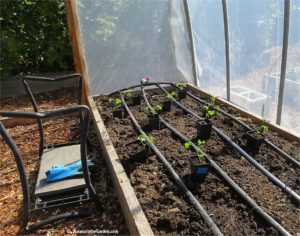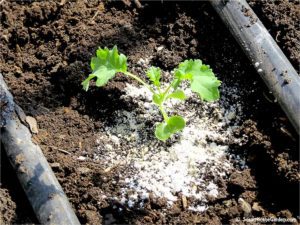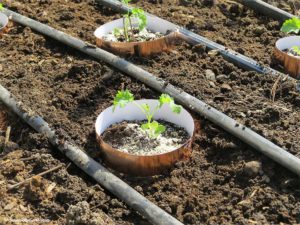Thwarting slugs!

How do you feel about slugs? If you just shuddered and if your blood pressure just went up a few notches, we’re on the same page! I despise slugs. Why? They seem to want to eat the very same veggies that I love to grow and eat. Yet they can be tricky to control, especially organically.
That said, I’m willing to be creative and try everything I can. I want to gain the upper hand in my battle against slugs.
You might already know that I have a small hoop house, which I use for growing vegetables through the fall and winter months. That can be challenging in a chilly northern climate like mine (I live in Spokane, Wash.) but it’s definitely possible.
You’d think the weather would be my biggest challenge but I’ve discovered slugs are far tougher than I ever thought possible. I can’t tell you how many times I’ve gone out to the hoop house in the dead of winter to check on the plants, only to find a slug happily munching on the kale or spinach leaves. Unbelievable!
I always thought they were rather tropical and assumed that once the cold weather hit, they’d die out. Nope. They probably really like me since I provide them with fresh greens when everything else has frozen out.
OK, time to get to the point of this post! About a month ago, I started some ‘Vates’ kale from seed indoors. ‘Vates’ is one of the most cold-tolerant kale cultivars around, by the way. Unfortunately, slugs think it’s pretty tasty.
Knowing this before I transplanted them into the hoophouse beds, I decided I wasn’t going to let them get the upper hand this time.
Here’s what I did:
- I spaced the kale plants so they’re not growing too closely together. Slugs like crowded plants because that makes it easier for them to move from one plant to the next.
- Once the plants were in, I sprinkled some diatomaceous earth (DE) around the bases. DE is made from the fossilized remains of diatoms (algae) and while it’s safe for us to handle — although I wouldn’t want to inhale it — it has teeny tiny sharp edges that cut the slug’s skin, making it dehydrate and die.
- The next step was to use something I’ve never tried before: Corry’s Slug & Snail Copper Tape Barrier. Apparently the slime from slugs reacts with copper giving them “an unpleasant sensation.” I’ve heard of gardeners having good luck with it so decided to give it a try. The rolls of tape are 15 feet long. Since my raised beds are 3 feet wide by 8 feet long, I knew that wouldn’t work. Instead, I made rings of it and placed them around the base of each kale plant. I made sure each ring contacted the soil well so a slug couldn’t sneak underneath it, and I also propped up any leaning plants so the leaves wouldn’t be touching the soil outside of the copper ring.
- Last but not least, I sprinkled some organic slug bait (Sluggo) here and there on the surface of both beds since I wasn’t able to protect all of the plants with the copper rings. As a matter of fact, it would’ve been difficult to use the copper around block plantings of, say, spinach, corn salad or miner’s lettuce.
We’ll see how all of this works. It might sound like overkill but it you’ve fought slugs as long as I have, you can probably relate! One other thing I wanted to mention regarding the copper tape is that many folks with raised beds will attach the tape around the outside of the bed to keep slugs from going into the beds. The tape has an adhesive backing. However, if you decide to go that route, I’d recommend stapling the tape to your bed because I’ve heard the adhesive doesn’t weather well.
I’ll report back on how my strategies have worked!



